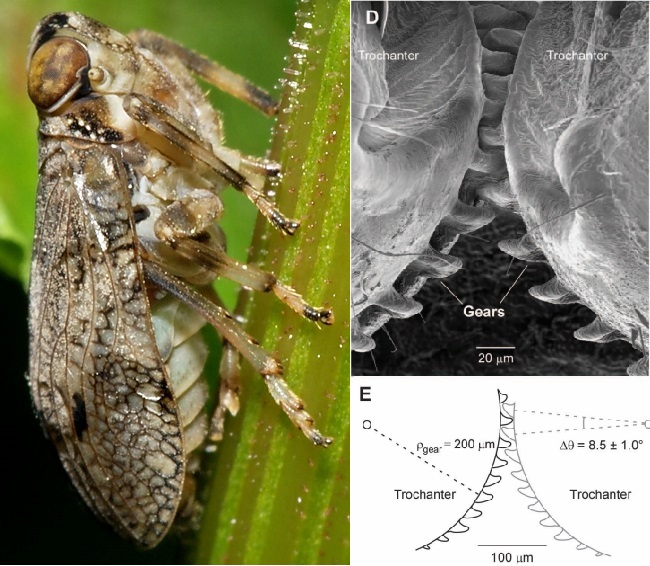Robert Kuzban wrote today about the recent discovery of an insect possessing a gear-shaped part, and the context and reception of this discovery.

Recently published in Science, Malcolm Burrows and Gregory Sutton wrote about the feature explicitly in terms of its function: what it’s for:
. . . the primary role of the gears is to ensure that the hindlegs move synchronously within microseconds of each other.
As Kurzban noted, this deduction of purpose from form was not accompanied by identification of heritability, advantage at reproduction or survival, or identification of the genes responsible for the feature. This is so, even though the gear’d legs require cognitive as well as physical features to work properly (jumping is a behavior, and the nerves controlling the action must be carefully configured).
The story of this fascinating grasshopperian has been widely featured in the media. One might think there would be some anti-adaptationist push-back for these researchers leaping (pardon the use) to the conclusion of purpose from mere form. There has been none, so far as I know.
I hope it seems obvious that the leg gearing is probably for the synchronization. Burrows and Sutton certainly make a convincing case for it. It is just this sort of intuitive deduction that unsophisticated critics of evolutionary psychology blast researchers for before citing the lack of identified genes or other uncomprehending arguments. And Burrows & Sutton might be wrong, but they’re definitely just suggesting a reasonable hypothesis based on an examination of what the parts appear to be doing. This is exactly what evolutionary psychologists do, except that it’s all wrong when we do it.
The Just-So Storytellers
We do tell Just-so stories. It’s about half of what science is, and what scientists do. In physics, it’s an entire subdomain, theoretical physics. Every idea in science started out as an hypothesis and every hypothesis is nothing more than a story we tell because we think it might be true, but don’t know for sure. If we did know, there’d be no reason to experiment. There is no one “right” way to form hypotheses. They come from daily musings, dreams, intuition and extension of other ideas. Ideally, hypotheses are based on and informed by existing knowledge, but it is often the case that an infinite number of possible explanations are consistent with existing knowledge, so there is no formal way to start with facts A, B, and C and get hypothesis D mathematically (in most cases).
So what really matters is the testing part. Looking back on the last few decades, I know of evolutionary psychology hypotheses that have been experimentally disconfirmed. If memory serves, in each of these cases this was done by evolutionary psychologists themselves. I have experimentally disconfirmed my own hypotheses. At the same time, many of the sharp-tongued critics have never done so: Stephen Jay Gould, Elisabeth Lloyd, David Buller, Steven Rose. Which story-teller is more troubling to the science? The ones who do the testing, or the ones who tell their own stories and call it a day?
Further reading
Malcolm Burrows, Gregory Sutton (2013) Interacting Gears Synchronize Propulsive Leg Movements in a Jumping Insect. Science 341, 1254. http://www.sciencemag.org/content/341/6151/1254
A Clockwork Insect: Garden bug sports mechanical gears PBS
